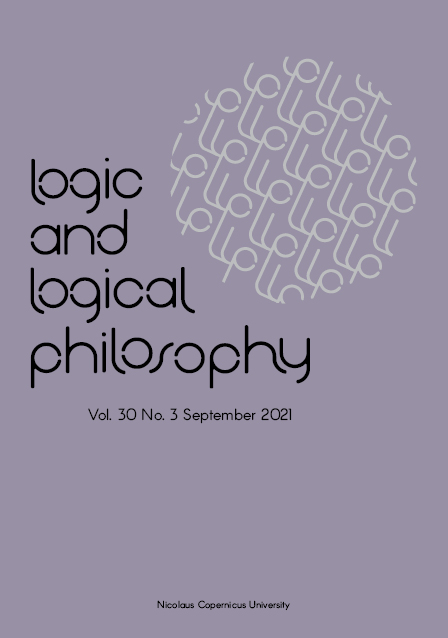Modal multilattice logics with Tarski, Kuratowski, and Halmos operators
DOI:
https://doi.org/10.12775/LLP.2021.003Słowa kluczowe
multilattice logic, modal logic, sequent calculus, algebraic completeness, neighbourhood semantics, embedding theoremAbstrakt
In this paper, we consider modal multilattices with Tarski, Kuratowski, and Halmos closure and interior operators as well as the corresponding logics which are multilattice versions of the modal logics MNT4, S4, and S5, respectively. The former modal multilattice logic is a new one. The latter two modal multilattice logics have been already mentioned in the literature, but algebraic completeness results have not been established for them before. We present a multilattice version of MNT4 in a form of a sequent calculus and prove the algebraic and neighbourhood completeness theorems for it. We extend the algebraic completeness result for the multilattice versions of S4 and S5 as well.
Bibliografia
Arieli, O., and A. Avron, “Reasoning with logical bilattices”, Journal of Logic, Language and Information 5 (1996): 25–63. DOI: http://dx.doi.org/10.1007/BF00215626
Avron, A., “The method of hypersequents in the proof theory of propositional non-classical logic”, pages 1–32 in Logic: from Foundations to Applications, 1996.
Bednarska, K., and A. Indrzejczak, “Hypersequent calculi for S5: The methods of cut elimination”, Logic and Logical Philosophy, 24, 3 (2015): 277–311. DOI: http://dx.doi.org/10.12775/LLP.2015.018
Cattaneo, G., and D. Ciucci, “Lattices with interior and closure operators and abstract approximation spaces”, pages 67–116 in J.F. Peters, A. Skowron, M. Wolski, M.K. Chakraborty and W.-Z. Wu (eds.), Transactions on rough sets X, vol. 5656 of “Lecture Notes in Computer Sciences”, Berlin: Springer, 2009. DOI: http://dx.doi.org/10.1007/978-3-030-01162-8_2
Chellas, B.F., Modal Logic. An Introduction, Cambridge: Cambridge University Press, 1980. DOI: http://dx.doi.org/10.1017/CBO9780511621192
Grigoriev, O., and Y. Petrukhin, “On a multilattice analogue of a hypersequent S5 calculus”, Logic and Logical Philosophy 28, 4 (2019): 683–730. DOI: http://dx.doi.org/10.12775/LLP.2019.031
Grigoriev, O., and Y. Petrukhin, “Two proofs of the algebraic completeness theorem for multilatticelogic”, Journal of Applied Non-Classical Logics 29, 4 (2019): 358–381. DOI: http://dx.doi.org/10.1080/11663081.2019.1647654
Indrzejczak, A., “Sequent calculi for monotonic modal logics”, Bulletin of the Section of logic 34, 3 (2005): 151–164.
Indrzejczak, A., Natural Deduction, Hybrid Systems and Modal Logics, Springer, 2010. DOI: http://dx.doi.org/10.1007/978-90-481-8785-0
Indrzejczak A. “Two is enough Ű- bisequent calculus for S5”, pages 277–294 in A. Herzig and A. Popescu (eds.), Frontiers of Combining Systems. FroCoS 2019, vol. 11715 of “Lecture Notes in Computer Science”, Springer, Cham. 2019. DOI: http://dx.doi.org/10.1007/978-3-030-29007-8_16
Kamide, N., “Phase semantics for multilattice formalism", pages 31–36 in IEEE 47th International Symposium on Multiple-Valued Logic (ISMVL), Novi Sad, 2017. DOI: http://dx.doi.org/10.1109/ISMVL.2017.13
Kamide, N., “A substructural view of multilattice logic”, Multiple-Valued Logic and Soft Computing 33, 3 (2019): 239–270.
Kamide, N., and Y. Shramko, “Embedding from multilattice logic into classical logic and vice versa”, Journal of Logic and Computation 27, 5 (2017): 1549–1575. DOI: http://dx.doi.org/10.1093/logcom/exw015
Kamide, N., and Y. Shramko, “Modal multilattice logic”, Logica Universalis 11, 3 (2017): 317–343. DOI: http://dx.doi.org/10.1007/s11787-017-0172-5
Kamide, N., Y. Shramko and H. Wansing, “Kripke completeness of biintuitionistic multilattice logic and its connexive variant”, Studia Logica 105, 5 (2017): 1193–1219. DOI: http://dx.doi.org/10.1007/s11225-017-9752-x
Kripke, S., “Semantical analysis of modal logic I”, Zeitschrift für Mathematische Logik und Grundlegen der Mathematik 9 (1963): 67–96.
Mints, G., “Some calculi of modal logic” [in Russian], Trudy Mat. Inst. Steklov. 98 (1968): 88–111.
Mints, G., “Cut-free calculi of the S5 type”, pages 79–82 in Studies in Constructive Mathematics and Mathematical Logic, part 2, 1970. DOI: http://dx.doi.org/10.1007/978-1-4899-5327-8_16
Ohnishi, M., and K. Matsumoto, “Gentzen method in modal calculi I”, Osaka Mathematical Journal 9, 2 (1957): 113–130.
Ohnishi, M., and K. Matsumoto, “Gentzen method in modal calculi II”, Osaka Mathematical Journal 11, 2 (1959): 115–120.
Poggiolesi, F., Gentzen Calculi for Modal Propositional Logic, Springer, 2011. DOI: http://dx.doi.org/10.1007/978-90-481-9670-8
Pottinger, G., “Uniform cut-free formulations of T, S 4 and S 5 , (abstract)”, Journal of Symbolic Logic 48 (1983): 900. DOI: http://dx.doi.org/10.2307/2273495
Restall, G., “Proofnets for S5: Sequents and circuits for modal logic”, pages 151–172 in Logic Colloquium 2005, vol. 28 of series “Lecture Notes in Logic”, Cambridge University Press, 2007. DOI: http://dx.doi.org/10.1017/CBO9780511546464.012
Shramko, Y., “Truth, falsehood, information and beyond: the American plan generalized”, pages 191–212 in K. Bimbo (ed.), J. Michael Dunn on Information Based Logics, vol. 8 of the Outstanding Contributions to Logic book series, Dordrecht: Springer, 2016. DOI: http://dx.doi.org/10.1007/978-3-319-29300-4_11
Shramko, Y., and H. Wansing, “Some useful sixteen-valued logics: How a computer network should think”, Journal of Philosophical Logic 34 (2005): 121–153. DOI: http://dx.doi.org/10.1007/s10992-005-0556-5
Zaitsev, D., “A few more useful 8-valued logics for reasoning with tetralattice EIGHT4”, Studia Logica 92, 2 (2009): 265–280. DOI: http://dx.doi.org/10.1007/s11225-009-9198-x
Pobrania
Opublikowane
Jak cytować
Numer
Dział
Statystyki
Liczba wyświetleń i pobrań: 1141
Liczba cytowań: 0







